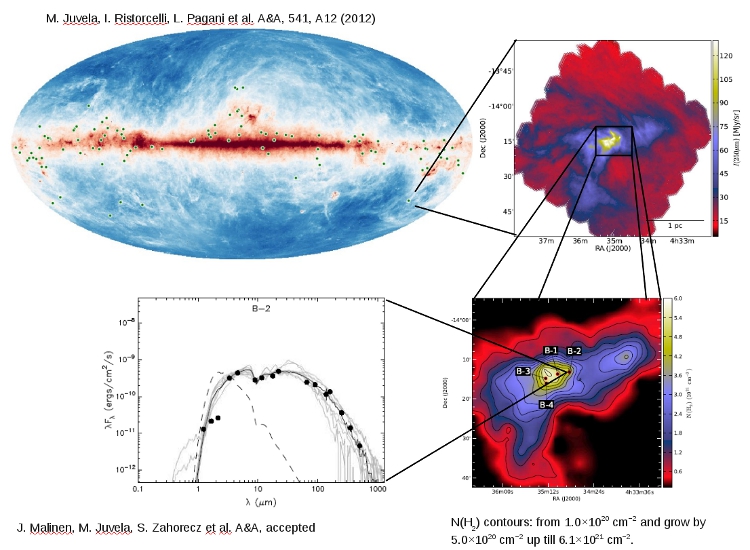| EPoS Contribution |
|
Cold cloud cores and young stellar objects in the Herschel Galactic Cold Cores project
Sarolta Zahorecz ESO, Munich, DE | |
| What are the physical conditions at the earliest stage of star formation? The Planck satellite offered a unique all-sky survey of the coldest clouds in the sky. Based on these Planck data cold clouds were studied with Herschel at higher spatial resolution and a sub-sample also with complementary spectral line data from Effelsberg. We investigated the star formation properties of these clouds in an unbiased survey as part of the Herschel open time key program "Galactic cold cores". Herschel PACS and SPIRE mapping of the selected 83 Planck cold clouds allowed us to examine the structure and physical characteristics of the sources and their environment. The observed clouds have distances ranging from 100 pc to 2800 pc, and masses from a few solar masses to 50000 solar masses. Most fields contain some filamentary structures. Complementary molecular line measurements confirmed the low temperatures and high densities derived from the FIR data. The densest clumps were also observed with the Effelsberg 100-m radio telescope in the NH3(1,1) and (2,2) lines, and 20 cores were located. The temperature and density distribution of the cores were modeled with the use of radiative transfer simulation of the line emission. We made a detailed analysis of associated mid- and far-infrared point sources in the Planck cold clouds. We determined the evolutionary phases of almost 900 young stellar candidates and estimated the physical parameters of more than 100 young stellar and proto-stellar objects with pre-computed radiative transfer models. Based on this diverse dataset of a unique sample of cold clouds, we set tight constraints on the early conditions during cloud and star formation. | |
 | |
| Caption: (Top left) The locations of the observed fields as part of the Herschel open time key program "Galactic cold cores", the background is the IRAS 100 μm map and the circles denote the positions of the fields. (Top right) Herschel 250 μm intensity map of one of the observed fields, L1642. (Bottom left) SED of the source B-2 in L1642, fitted with the YSO models of Robitaille et al. (2007). Filled circles show the fitted 2MASS, WISE), AKARI and Herschel fluxes. The solid black line shows the best-fitting model, and the possible gray lines the 10 the best-fitting model. (Bottom right) H2 column density map derived from 13CO for L1642, reproduced from the data of Russeil et al. (2003). The positions of the four compact sources are marked. | |
| Collaborators: L. V. Toth, Eotvos University, Hungary Galactic Cold Cores Team (PIs: Juvela, M. and Ristorcelli, I.) |
Key publication
Suggested Sessions: Cores |

